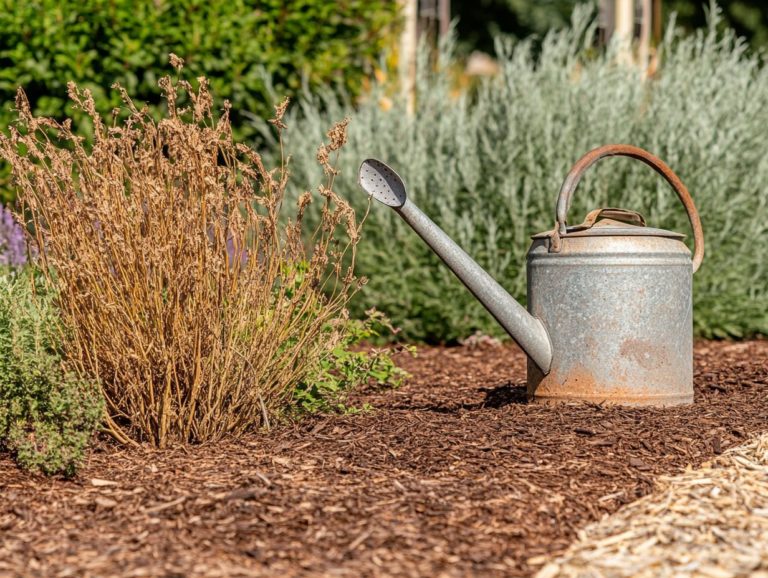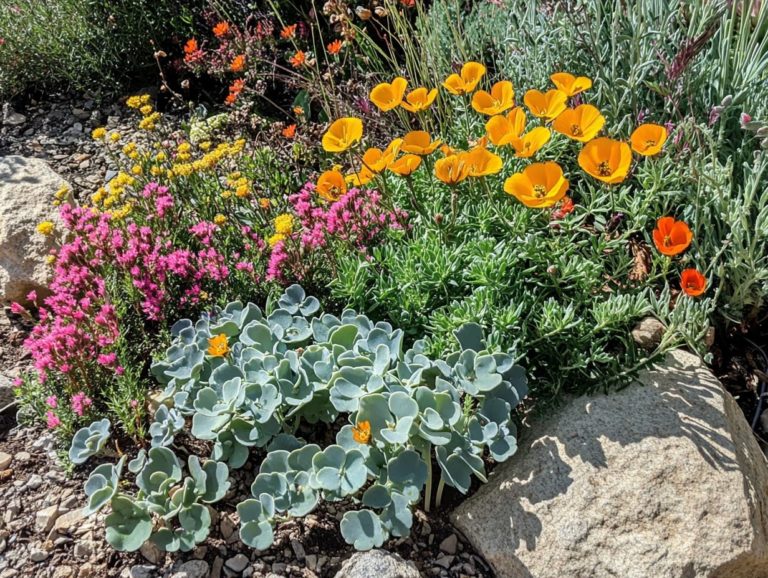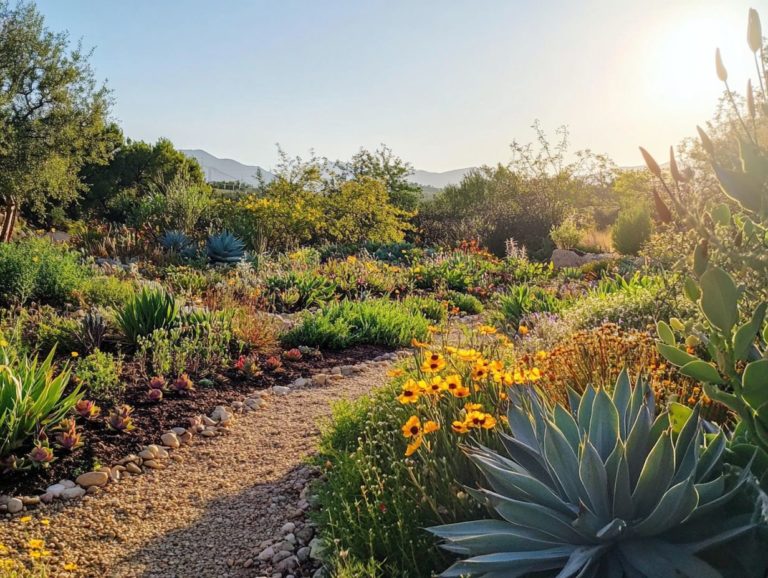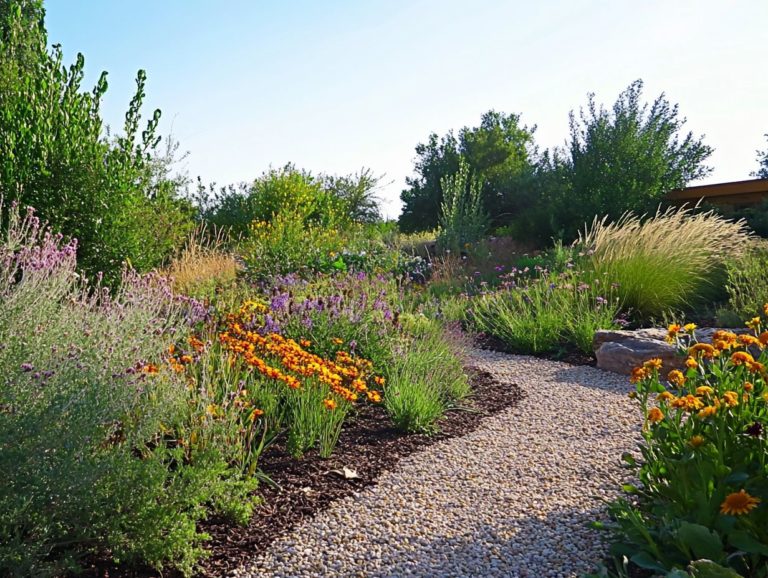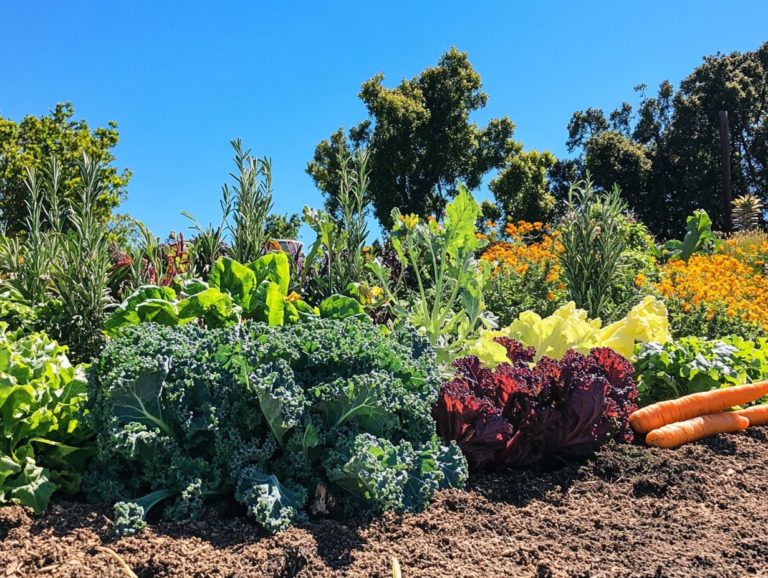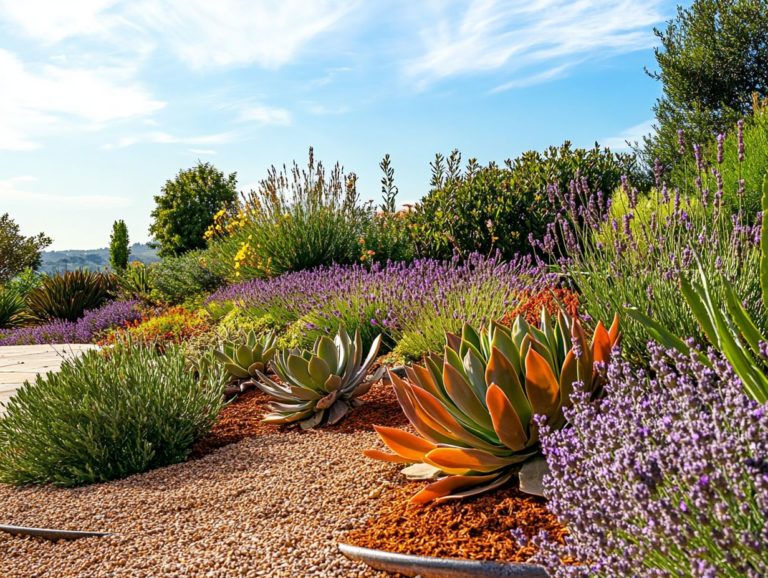How to Research Local Drought-Resistant Species?
Dive into the world of drought-resistant plants! As climate change brings more dry spells, learning about these resilient species can transform your garden and the environment. It’s essential to understand and utilize drought-resistant species for sustainable gardening and landscaping. These hardy plants thrive in arid conditions and offer significant environmental and economic benefits.
Get ready to discover how you can easily identify local drought-resistant plants while emphasizing the importance of consulting local experts. Explore key factors to consider when selecting these plants and discover practical tips for smoothly integrating them into your garden.
Together, you can cultivate a more resilient landscape!
Contents
- Key Takeaways:
- Understanding Drought-Resistant Species
- Benefits of Using Drought-Resistant Species
- Researching Local Drought-Resistant Species
- Factors to Consider When Choosing Drought-Resistant Species
- Implementing Drought-Resistant Species in Your Garden
- Frequently Asked Questions about drought-resistant gardens
- How do I research local drought-resistant species?
- What are some benefits of researching local drought-resistant species?
- What criteria should I consider when researching local drought-resistant species?
- How can I determine if a plant is drought-resistant?
- Where can I find information about local drought-resistant species?
- How can I incorporate local drought-resistant species into my landscaping?
Key Takeaways:
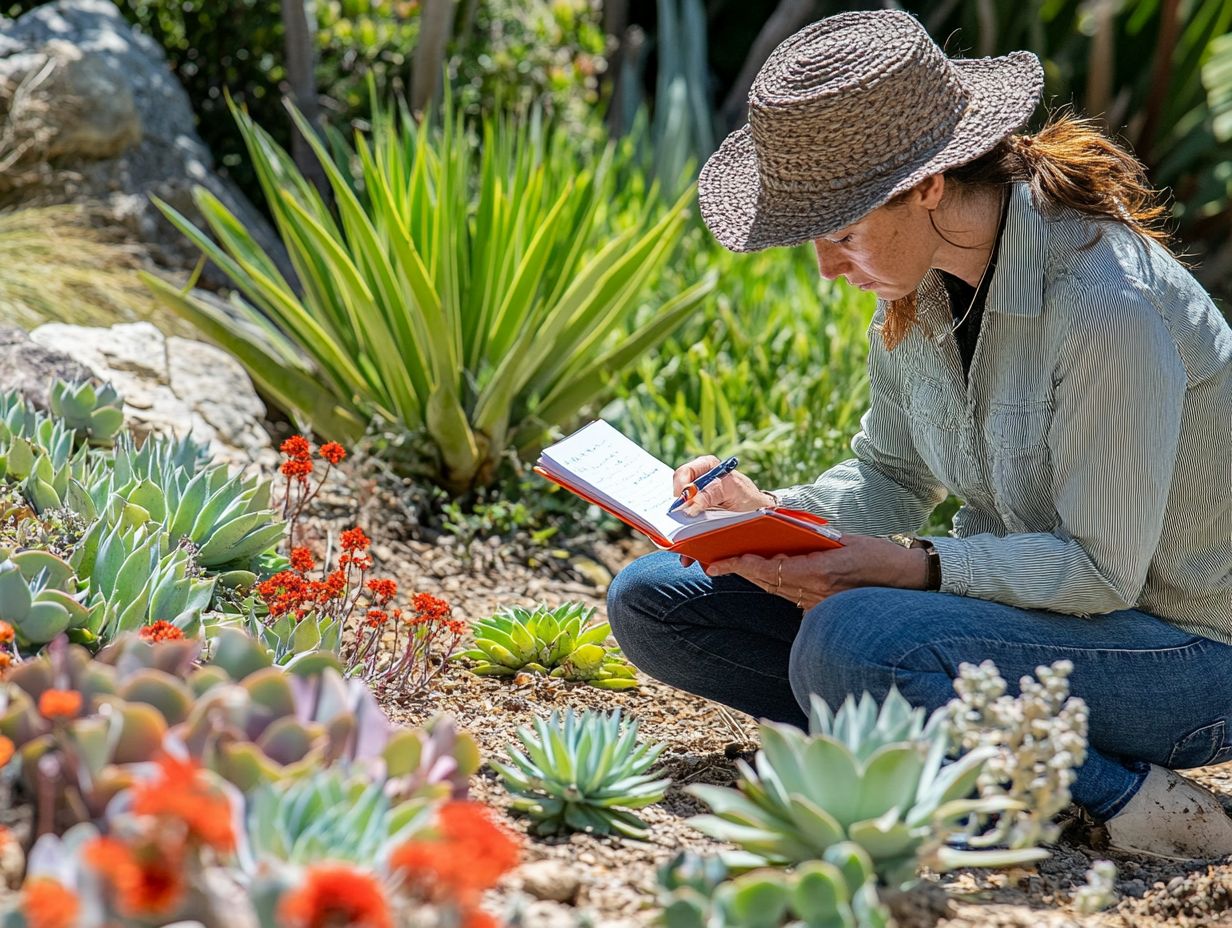
- Choose native species for a more successful and sustainable drought-resistant garden.
- Consult with experts and local resources to determine the best drought-resistant species for your specific climate and soil conditions.
- Proper planting and care techniques are crucial for the success of drought-resistant species and creating a beautiful, water-efficient landscape.
Understanding Drought-Resistant Species
Understanding drought-resistant species is crucial for crafting sustainable gardens, especially in regions facing increasing droughts due to climate change. These plants are perfectly adapted to thrive in low-water environments, making them key players in drought-tolerant landscaping and water-efficient gardening.
By incorporating native plants into your garden, you promote biodiversity and enhance soil health. This fosters a vibrant ecosystem that supports pollinators such as Monarch butterflies, birds, and other wildlife, all while significantly reducing water usage.
What are Drought-Resistant Species?
Drought-resistant species are your go-to plants for thriving in arid environments, requiring minimal water and care. They’re perfect for crafting a drought-tolerant landscape.
These plants also conserve water and play a vital role in maintaining the ecological balance of their surroundings. By using native species in your gardening practices, you create habitats that boost local biodiversity, providing shelter and nourishment for various pollinators and wildlife.
Choosing drought-resistant species promotes sustainable gardening by minimizing the need for chemical fertilizers and pesticides. This leads to healthier soil and ecosystems. These resilient plants can thrive with little intervention, ensuring your garden remains vibrant even in challenging climates.
Ultimately, you’ll foster a climate-resilient landscape that benefits both the environment and your gardening endeavors.
Benefits of Using Drought-Resistant Species
By opting for drought-resistant species, you unlock a wealth of benefits that span both environmental and economic realms, particularly in areas facing extended drought conditions.
Environmental and Economic Advantages
The environmental advantages of utilizing drought-resistant species are substantial. They improve soil health, boost biodiversity, and contribute to water conservation initiatives.
By including these resilient plants in your urban landscapes, you cultivate healthier ecosystems that support diverse wildlife and address challenges like soil erosion and water runoff. This proactive strategy fosters greener urban environments, reducing urban heat islands and leading to lower energy costs for residents.
Take cities like Phoenix, for example; they’ve successfully implemented water conservation initiatives highlighting the effectiveness of drought-tolerant landscaping. This approach has significantly decreased water usage and serves as an exemplary model for other regions. Economically, these practices can reduce municipal water expenses while enhancing the aesthetic and environmental quality of urban spaces.
Researching Local Drought-Resistant Species

Researching local drought resistance in plant species is essential for creating effective drought-tolerant landscaping. By selecting these native plants, you enhance the beauty of your outdoor space while providing vital support for local wildlife and ecosystems.
Identifying Native Species
Identifying native species in your area is an essential step in crafting a drought-resistant garden. This garden supports local ecosystems and enhances biodiversity.
To achieve this, you can tap into a variety of resources. Local plant guides are invaluable, offering insights into the flora that s indigenous to your region.
A visit to botanical gardens can reveal which plants thrive in your specific climate and soil conditions. This gives you a firsthand look at nature’s best options.
Engaging with local environmental organizations and gardening clubs can also prove advantageous. These groups often host programs and workshops centered on native species.
By selecting plants that have adapted to local drought conditions, you ensure that your garden flourishes with minimal water. This boosts ecological resilience and provides a haven for native wildlife.
Ultimately, this helps to maintain the delicate balance of the ecosystem.
Consulting with Experts and Local Resources
Consulting with experts and leveraging local resources can significantly enhance your understanding of drought-resistant landscaping.
By reaching out to local plant experts, extension services, and community gardening clubs, you tap into a rich reservoir of localized knowledge.
These experts can offer invaluable insights into native plants that thrive in urban settings while requiring minimal water. Working together improves your gardening practices and fosters a sense of community and sustainability.
This collaborative approach guides you in creating habitats that conserve water and support local wildlife.
It also contributes to more resilient urban landscapes that adapt seamlessly to changing climate conditions.
Factors to Consider When Choosing Drought-Resistant Species
When selecting drought-resistant species, consider a variety of factors. Take into account the specific climate and soil conditions of your area.
Also, think about the water needs and maintenance requirements of the plants you re contemplating.
Climate and Soil Conditions
Understanding the climate and soil conditions is essential when selecting drought-resistant species. These factors heavily influence the success of your water-wise gardening endeavors.
Different regions boast unique climate patterns. Variations in temperature, humidity, and precipitation determine which plants can thrive in your area.
Soil types from sandy soils that drain swiftly to clay soils that hold moisture are crucial in assessing plant adaptability.
Healthy soil is vital for drought-resistant plants. It enhances water retention, provides essential nutrients, and fosters robust root systems.
For example, plants like lavender and succulents flourish in sandy, well-drained conditions.
In contrast, native grasses thrive in heavier soils. This underscores the necessity of aligning the right species with their environmental context.
Your landscaping success hinges on this thoughtful matching.
Water Needs and Maintenance

Evaluating the water needs and maintenance of drought-resistant plants is essential for establishing sustainable gardens. These gardens thrive even in challenging conditions.
Understanding how different species respond to varying moisture levels is crucial for crafting a successful landscape.
Factors such as soil type, climate, and seasonal rainfall all play significant roles in determining these requirements.
Take succulents like agave and native grasses, for example; they flourish with minimal water.
This makes them perfect candidates for a low-maintenance garden design.
By incorporating these resilient plants, you can significantly reduce irrigation needs while promoting ecological balance.
Making smart plant choices not only saves water but also creates a thriving garden that bursts with life!
This thoughtful selection conserves resources and cultivates a harmonious environment where plants coexist naturally. It simplifies upkeep and lessens the demands on your time and energy.
Start your journey today by exploring local plant options and joining a community gardening club!
Implementing Drought-Resistant Species in Your Garden
Transform your garden into a drought-resistant oasis today! Implementing drought-resistant species requires a thoughtful approach that blends strategic planning with careful planting methods and an eye for landscape design. This ensures your garden can thrive even in the face of ecological drought conditions.
Want Your Drought-Resistant Plants to Thrive?
Here s how to care for them effectively. Proper planting and care techniques are crucial for ensuring the success of drought-resistant species, enabling them to thrive while promoting effective water conservation.
Know the best times to plant. Early spring or fall is ideal for helping resilient plants establish roots before harsh weather. Amending the soil with organic matter significantly enhances its structure and drainage, promoting nutrient availability and moisture retention.
Once your plants are established, adopting a watering strategy that mimics natural rainfall patterns is vital. Deep but infrequent watering encourages deeper root growth, allowing your plants to withstand dry spells more effectively. Using mulch helps regulate soil temperature and moisture levels, boosting the overall resilience of these plants against the challenges of a changing climate.
Creating a Drought-Resistant Landscape Design and Water-Wise Landscaping
Crafting a drought-resistant landscape design requires you to thoughtfully integrate various elements that foster biodiversity, create habitats, and establish resilient ecosystems capable of enduring drought conditions.
This approach enhances the visual allure of your space and supports local wildlife and native plant species. By carefully selecting drought-tolerant plants, such as succulents and native grasses, you can significantly cut down on water consumption while still achieving a vibrant and inviting aesthetic.
Consider layout strategies, such as grouping plants with similar water needs and incorporating features like rock gardens or gravel paths, to elevate both functionality and beauty. Adding elements like bird baths or bee hotels can also cultivate a flourishing ecosystem, attracting beneficial species that enhance the overall health of your landscape and support urban forest ecosystems.
Frequently Asked Questions about drought-resistant gardens
How do I research local drought-resistant species?
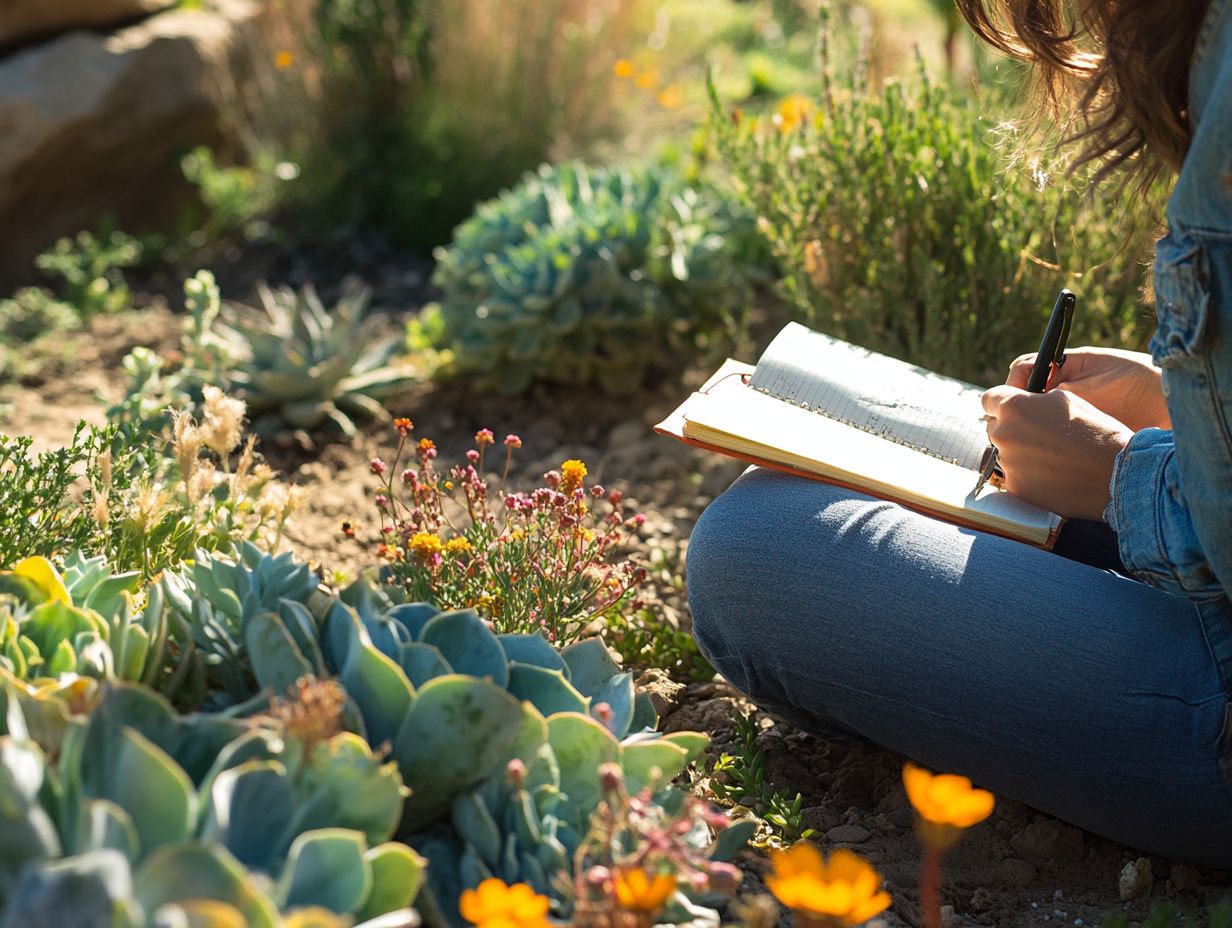
To research local drought-resistant species, start by consulting with local experts, such as botanists or horticulturalists, knowledgeable about the plants in your specific region. You can also do online research and visit local nurseries or gardening centers to gather information about where to buy drought-resistant plants locally in your area.
What are some benefits of researching local drought-resistant species?
Researching local drought-resistant species allows you to choose plants best adapted to your area’s climate and soil conditions. For more information, check out the best resources for drought gardening. These plants are more likely to thrive and require less maintenance, saving you time and resources. Additionally, by choosing native plants, you support the local ecosystem and promote biodiversity.
What criteria should I consider when researching local drought-resistant species?
When researching local drought-resistant plant varieties, consider factors such as the plant’s water requirements, sun exposure needs, and soil type preferences. You should also evaluate the plant’s growth rate, size, and aesthetic qualities to ensure it fits well in your landscape.
How can I determine if a plant is drought-resistant?
There are a few key characteristics to look for when determining if a plant is drought-resistant. These include thick, waxy leaves; deep root systems; and gray or silvery foliage. Plants with these features conserve water better and withstand periods of drought.
Where can I find information about local drought-resistant species?
You can find information about local drought-resistant species from various sources, including local gardening clubs, university extension offices, and state or regional horticultural websites. Additionally, you can check out local resources for drought gardening by consulting with your local cooperative extension service or visiting your nearest botanical gardens for information on native plants.
How can I incorporate local drought-resistant species into my landscaping?
You can easily add local drought-resistant plants to your landscape. Start by replacing thirsty plants with varieties that need less water.
Consider creating a rain garden. This special garden captures and filters excess water, making it useful for your plants.
Using mulch helps keep moisture in the soil, which is essential for plant health.
Consulting with a landscape designer or gardening expert can provide you with personalized tips. They can help you plan a successful drought-resistant landscaping project.

